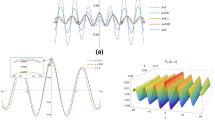Abstract
The probability density function (pdf) of successive intervals of a truncated, nonhomogeneous Poisson process was examined under both low- and high-frequency conditions. In general, if the instantaneous rate contains a single frequency component, then the phase of this component is not represented in the interval pdf. However, if the instantaneous rate contains harmonically related components, with fundamental frequency of the same order as, or less than, the mean rate, then the phases of these components do appear in the interval pdf. Correction formulae for estimating synchronization indices under low-frequency conditions are derived.
Similar content being viewed by others
References
Abramowitz M, Stegun IA (1965) Handbook of mathematical functions. Dover, New York.
Bi Q, Brown JL Jr, Lachs G (1988) Statistical expectation of the interval histograms from marginal time statistics of the Poisson process. J Acoust Soc Am 83:1186–1189.
Cooper NP (1989) On the peripheral coding of complex auditory stimuli: Temporal discharge patterns in guinea-pig cochlear nerve fibres. PhD thesis, University of Keele, Staffordshire, UK.
Goldstein JL (1973) An optimum processor theory for the central formation of the pitch of complex tones. J Acoust Soc Am 54:1496–1516.
Gummer AW (1991a) First order temporal properties of spontaneous and tone-evoked activity of auditory afferent neurones in the cochlear ganglion of the pigeon. Hear Res (in press).
Gummer AW (1991b) Postsynaptic inhibition can explain the concentration of short inter-spike-interval in avian auditory nerve fibres. Hear Res (in press).
Johnson DH (1974) The response of single auditory-nerve fibers in the cat to single tones: Synchrony and average discharge rate. PhD thesis, Massachusetts Institute of Technology, Cambridge, Mass.
Kate JH ten, Bekkum MF van (1988) Synchrony-dependent autocorrelation in eight-nerve-fiber response to rippled noise. J Acoust Soc Am 84:2092–2102.
Kiang NY-S (1965) Discharge patterns of single fibers in the cat's auditory nerve. MIT Press, Cambridge.
Manley GA, Gleich O, Leppelsack H-J, Oeckinghaus H (1985) Activity patterns of cochlear ganglion neurones in the starling. J Comp Physiol A 157:161–181.
Popper AN, Fay RR (1980) Comparative studies of hearing in vertebrates. Springer, New York Berlin Heidelberg.
Press WH, Flannery BP, Teukolsky SA, Vetterling WT (1988) Numerical recipes. Cambridge University Press, Cambridge New York.
Redman S (1990) Quantal analysis of synaptic potentials in neurons of the central nervous system. Physiol Rev 70:165–198.
Sachs MB, Young ED (1980) Effects of nonlinearities on speech encoding in the auditory nerve. J Acoust Soc Am 68:858–875.
Siebert WM (1970) Frequency discrimination in the auditory system: Place or periodicity mechanisms? Proc IEEE 58:723–730.
Snyder DL (1975) Random point processes. Wiley, New York.
Author information
Authors and Affiliations
Rights and permissions
About this article
Cite this article
Gummer, A.W. Probability density function of successive intervals of a nonhomogeneous Poisson process under low-frequency conditions. Biol. Cybern. 65, 23–30 (1991). https://doi.org/10.1007/BF00197286
Received:
Accepted:
Issue Date:
DOI: https://doi.org/10.1007/BF00197286



